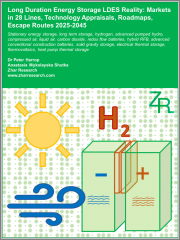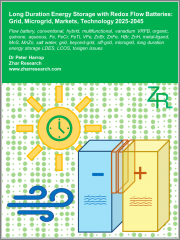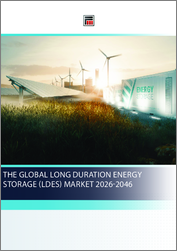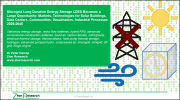
|
시장보고서
상품코드
1572665
세계의 LDES(장기 에너지 저장) 현황 : 28개 라인 시장, 기술 평가, 로드맵, 우회로(2025-2045년)Long Duration Energy Storage LDES Reality: Markets in 28 Lines, Technology Appraisals, Roadmaps, Escape Routes 2025-2045 |
||||||
세계 LDES(장기 에너지 저장) 시장을 조사했으며, 주요 LDES 기술 유형과 개요, 연구 진행 상황, 현재 성공 사례와 향후 가능성, 로드맵, SWOT 평가, 기술 비교 파라미터 표, 기술 카테고리-단위 규모-지역 등 각종 분류별 시장 예측 등의 정보를 전해드립니다. 등을 정리했습니다.
목차
제1장 주요 요약·결론
제2장 LDES 필요성과 설계 원칙
- 에너지 기초
- 급속한 비용 절감으로 재생에너지에의 참여를 가속
- 태양광발전 승리와 간헐성 과제
- LDES 우회로
- LDES 정의와 선택사항 비교
- 그리드와 그리드 밖 LDES에 대한 각종 요구
- 주요 프로젝트·주요 기술 부분집합
- LDES 장애·대체안·투자환경
- LDES 툴 키트
- 퍼포먼스 평가 : 기술별
- 기타
제3장 수소 및 기타 화학 중간체에 의한 LDES
- 개요
- 화학 중간체 LDES 스위트 스포트
- 2025년과 2024년 53 연구 진보
- LDES 메탄 및 암모니아와 수소 비교
- 수소 LDES 리더 : Calistoga Resiliency Centre USA 48시간 수소 LDES
- 최장기 LDES에서는 수소가 승리하는 것이 판명
- 광업 대형은 신중하게 많은 선택사항을 진행시키고 있다
- 건물이나 기타 좁은 장소
- 수소 저장 기술
- LDES 수소 저장 파라미터 평가
- SWOT 평가 : LDES 수소·메탄·암모니아
제4장 양수 발전 : 기존 PHES(양수 발전 에너지 저장)
- 개요 : 와 력·환경·3유형·타임스케이르·후보지·DOE 평가
- 연구 진보 등
- 세계의 프로젝트와 목적
- 경제성
- 정책 제안
- 기존 양수 발전 PHES 파라미터 평가
- 기존 양수 발전 PHES SWOT 평가
제5장 APHES(첨단 양수 발전 에너지 저장)
- 개요
- 연구 진보
- 가압 지하 : Quidnet Energy USA
- 스웨덴 광산 저장
- RheEnergise UK
- 바다에서 육지에의 S-PHES·해상 댐 이용
- StEnSea Germany·Ocean Grazer Netherlands : 기타 수중 LDES라는 비교
- LDES 용수중 에너지 저장 SWOT 평가
- Cavern Energy USA
- APHES SWOT 평가
제6장 CAES(압축 공기 에너지 저장)
- 개요
- 공급 부족이 클론을 끌어 들인다
- CAES 시장 포지셔닝
- CAES와 LAES 파라미터 평가
- CAES 기술 옵션
- CAES 제조업체·프로젝트·연구
- 개요
- Siemens Energy Germany
- MAN Energy Solutions Germany
- CAES 저장 시간과 방전 시간 연장
- 영국과 EU의 연구
- 시스템 설계자와 공급업체 CAES 개요와 평가
- ALCAES Switzerland
- APEX CAES USA
- Augwind Energy Israel
- Cheesecake Energy UK
- Corre Energy Netherlands
- Gaelectric failure Ireland - lessons
- Huaneng Group China
- Hydrostor Canada
- LiGE Pty South Africa
- Storelectric UK
- Terrastor Energy Corporation USA
- LDES CAES : SWOT 평가
제7장 RFB(Redox 플로우 배터리)
- 개요
- RFB 연구는 LDES로 축을 변경
- RFB LDES 프로젝트
- 승리를 가져오는 LDES 기술
- 44개 RFB 기업 비교
- RFB 기술
- 재료별 구체적 설계
- RFB 제조업체 개요
- LDES RFB 파라미터 비교 표
제8장 SGES(고체 중력 에너지 저장)
- 개요와 IIASA, 오스트리아 제안
- LDES SGES 파라미터 평가
- ARES USA
- Energy Vault Switzerland
- Gravitricity UK
- SinkFloat Solutions France
- LDES SGES : SWOT 평가
제9장 ACCB(첨단 기존 건설용 배터리)
- 개요
- beyond grid LDES에 관한 ACCB SWOT 평가
- ACCB 제조업체 8개사 비교
- 금속 공기 배터리
- 고온 배터리
- 금속 이온 배터리
- 니켈 수소 전지
- LDES ACCB 파라미터 평가
제10장 LGES(액화 가스 에너지 저장) : 액체 공기 LAES 또는 CO2
- 개요
- 액체 공기 LDES
- 기술
- 연구 진보
- CGDG China
- Highview Energy UK
- Sumitomo Japan and China
- Phelas Germany
- LDES LAES SWOT 평가
- LDES LAES 파라미터 비교
- 액체 이산화탄소 LDES
제11장 ETES(지연 전력을 위한 열에너지 저장)
- 개요
- 연구 진보
- 실패에서 알게 된 교훈
- 열기관 접근 성공 : Echogen USA
- 극단적인 온도와 광전 변환 이용
- Antora USA
- Fourth Power USA
- 1개 플랜트에서의 지연 열과 지연 전력 판매
- 개요
- MGA Thermal Australia
- Malta Inc Germany
- LDES ETES : SWOT 평가
- ETES 파라미터 평가
Summary
The race is on. From your solar house to your grid power, increasingly solar is the winner with wind a close second globally, both needing storage of increasing delay as their percentages rise. For 2025-2045, Long Duration Energy Storage LDES has arrived meaning eight hours or more of subsequent discharge at full rated power. That compensates solar dead at night and where lithium-ion stationary storage becomes far too expensive.
An independent report is required, appraising the many technologies, current successes, potential and latest research. It must consider escape routes reducing LDES need and the realistic forecasts that result. Welcome the new 560 page, commercially-oriented Zhar Research report, "Long Duration Energy Storage LDES Reality: Markets in 28 Lines, Technology Appraisals, Roadmaps, Escape Routes 2025-2045" .
Primary author Dr Peter Harrop advises that providing LDES for your solar house is some way off, but LDES at MW to GW levels and 10-24 hours duration is a huge immediate demand. Projects and commitments already involve six very different LDES technologies, mostly off-grid or capable of being off-grid. Gigawatt LDES levels mostly serve grids using two other LDES technologies so far, both needing major earthworks, more to come. Vital questions are answered including:
- LDES need after recognising escape routes such as nuclear, geological and ocean power with minimal intermittency, new wider grids spanning time and weather zones, hydrogen economy?
- 2025-2045 forecast lines by size of unit, region, 11 technology categories plus roadmaps, SWOT appraisals, parameter tables?
- Can grids be served with GWh LDES not needing large earthworks and delays? How? When?
- Big differences between small, medium and large LDES. For example, beyond-grid purchasers need small footprint (high energy density or safely stackable), low up-front cost, but grid needs low levelised cost of storage.
- Which technologies have the big advantage of adjusting power and capacity separately?
- Big breakthrough: Which technologies will economically compensate both short-term demand changes and long-term supply changes with one unit?
- Technologies ahead for small, medium and large power? For example, two very different types of underground water storage are being constructed as forms of Advanced Pumped Hydro Storage APHES. Watch iron redox flow batteries.
- Detailed predictions: Levelised Cost of Storage, capital cost, duration, life, operating costs, safety, toxigen and precious metal issues.
The report is the most comprehensive and up-to-date. It mentions over 100 companies in 11 chapters with research advances, company progress through 2024, 19 SWOT appraisals. There are 7 technology comparisons (17 parameters).
The Executive Summary and Conclusions (30 pages) is sufficient in itself, with 20 key conclusions, new infograms, roadmaps and those 28 forecast lines 2025-2045. Chapter 2, "LDES need and design principles" (20 pages), covers energy basics, escape routes from LDES such as nuclear, geothermal and ocean power, vehicle-to grid and some grids now spanning many weather and time zones. Here the conclusion is that LDES will still be a massive market but perhaps half of what some vested interests predict. It then covers LDES needs and introduces the technologies.
Chapter 3. "Hydrogen and other chemical intermediary LDES" (53 pages) focuses almost entirely on hydrogen. The others are uneconomic . Even hydrogen is highly contentious with very strong opinions either way enabled by a lack of data. Will there be a hydrogen economy permitting marginal pricing? Will the small Energy Vault above-ground hydrogen LDES being erected tell us much about the optimal giant underground hydrogen LDES?
Chapter 4. "Pumped hydro: conventional PHES" (17 pages) describes how this traditional approach, three types, has long achieved LDES that also provides short term response and has life on 100 years or more. There are plenty of potential sites but few will be approved. See the latest parameter comparison, improvements ahead such as low carbon, stronger concrete, SWOT appraisal then move to the reinvention of pumped hydro for where there are no steep cliffs. Chapter 5. "Advanced pumped hydro APHES" explains how pumping water into sprung rocks underground and pumping saltwater into caverns underground are now yielding encouraging data. Interesting ideas such as pumping heavy liquid up mere hills and water into sub-sea bladders are seeking meaningful funding.
Chapter 6. "Compressed air CAES" is very important, being the only technology beyond pumped hydro that the US DOE 2024 report finds can drop to a levelised cost of storage of under $50/MWh by 2030, something the world needs with its headlong adoption of wind and solar. See ten CAES companies appraised, 2024 research, , SWOT, predictions in 63 pages.
Just behind CAES in cost reduction potential is redox flow batteries. Many companies move into LDES versions for some grid applications but mostly off-grid or capable of being off-grid. They have small footprint, safely stackable, no massive earthworks and potentially very long duration and life.
Chapter 7. "Redox flow batteries RFB" therefore takes138 pages to profile 44 RFB manufacturers and developer, give the usual appraisal of 17 parameters and SWOT report but also make sense of a flood of academic progress in 2024. Why are iron and hybrid versions rapidly gaining share but not competing? Performance potential in 2035 and 2045?
Chapter 8. Solid gravity energy storage SGES (26 pages) looks at Gravitricity lifting weights in mines but not promising LDES, various small experiments and ideas. Contrast Energy Vault licensing Chinese companies to make giant versions, later likely to be LDES. See SWOT, parameter comparisons, projections, possible issues such as high capital and maintenance cost but good things too.
Chapter 9. "Advanced conventional construction batteries ACCB" mainly covers metal-air, molten salt and metal-ion batteries ignoring lithium-ion because it is unable to compete on cost from 2025-2045 at LDES durations. Most have the problem of coupled power and capacity so you just have to buy more of them as demand rises for ever larger grid units. Few improve on the leakage current of lithium-ion but one extreme is Form Energy being low in capital cost to compensate many weaknesses, attracting an eye watering $1.2 billion investment and the largest, longest duration grid LDES project beyond pumped hydro. Other ACCB are mostly best beyond-grid. They are very different, so see eight SWOT appraisals and many parameter comparisons, many academic advances in 2024 and routes forward. See eight families compared in eight columns on one of the 54 pages.
Chapter 10. "Liquefied gas energy storage LGES: Liquid air LAES or CO2" (21 pages) considers what is, in many respects, intermediate in parameters and benefits making them part of the grid and beyond-grid market with some projects and funding but no major success as yet.
Chapter 11. Thermal energy storage for delayed electricity ETES (18 pages) assesses how joule heating of rocks or other solids then returning to electricity with steam turbines has led to many company collapses, failing to compete in efficiency, duration or much else. Contrast one large 2024 project using heat pumps, supported by 2024 academic research presented here. Two other companies pursue a wild-card: incandescent storage temperatures, photovoltaically returning to heat when needed. See appraisals.
Zhar Research report, "Long Duration Energy Storage LDES Reality: Markets in 28 Lines, Technology Appraisals, Roadmaps, Escape Routes 2025-2045" is essential reading for those wishing to create multi-billion-dollar business in the materials and systems.
Table of Contents
1. Executive summary and conclusions
- 1.1. Purpose and scope of this report
- 1.2. Methodology of this analysis
- 1.3. Definitions and need
- 1.4. Nine primary LDES technologies and their subsets compared
- 1.5. Three LDES sizes, with different winners 2025-2045 on current evidence
- 1.6. Duration vs power of LDES technologies not needing major earthworks compared with others in 2025
- 1.7. Lessons from relative investment by company and technology to 2035
- 1.8. 20 key conclusions
- 1.9. Long Duration Energy Storage LDES roadmap 2025-2045
- 1.10. 28 Market forecasts 2025-2045
- 1.10.1. Total LDES value market percent in three size categories 2025-2045 table, graphs
- 1.10.2. Total LDES value market $ billion in three size categories 2025-2045 table, graphs
- 1.10.3. Regional share of LDES value market percent in four regions 2025-2045
- 1.10.4. Total LDES value market $billionX100 by four regions 2025-2045 table, graphs
- 1.10.5. Global LDES market $ billion 2025-2045
- 1.10.6. LDES market in 9 technology categories $ billion 2025-2045 table, graphs
- 1.10.7. LDES total value market showing beyond-grid gaining share 2025-2045
- 1.10.8. Vanadium vs iron vs other RFB LDES market % value sales 2025-2045
2. LDES need and design principles
- 2.1. Energy fundamentals
- 2.2. Racing into renewables with rapid cost reduction
- 2.3. Solar winning and the intermittency challenge
- 2.4. Escape routes from LDES
- 2.5. LDES definitions and choices compared
- 2.6. The very different needs for grid vs beyond-grid LDES 2025-2045
- 2.7. Leading projects in 2025 showing leading technology subsets
- 2.8. LDES impediments, alternatives and investment climate
- 2.9. LDES toolkit
- 2.9.1. Overview
- 2.9.2. LDES choices compared
- 2.9.3. Electrochemical LDES options explained
- 2.10. Latest independent assessments of performance by technology
- 2.11. Other aspects
3. Hydrogen and other chemical intermediary LDES
- 3.1. Overview
- 3.1.1. Hydrogen past and present: successes and failures
- 3.1.2. The proposal of a hydrogen economy: 2024 research advances
- 3.1.3. The UK as an example of contention
- 3.1.4. Wide spread of parameters means interpretation should be cautious
- 3.1.5. How hydrogen is both partner and alternative to electrification
- 3.2. Sweet spot for chemical intermediary LDES
- 3.3. 53 research advances reported in 2025 (pre-publication) and 2024
- 3.3.1. Introduction
- 3.3.2. New research on salt caverns, subsea and other options for large scale hydrogen storage
- 3.3.3. New research on complex mechanisms for hydrogen loss
- 3.3.4. New research on hydrogen leakage causing global warming
- 3.3.5. New research on combining grid hydrogen storage with other storage: hybrid systems
- 3.4. Hydrogen compared to methane and ammonia for LDES
- 3.5. Hydrogen LDES leader: Calistoga Resiliency Centre USA 48-hour hydrogen LDES
- 3.6. Calculations finding that hydrogen will win for longest term LDES
- 3.7. Mining giants prudently progress many options
- 3.8. Buildings and other small locations
- 3.9. Technologies for hydrogen storage
- 3.9.1. Overview
- 3.9.2. Choices of underground storage for LDES hydrogen
- 3.9.3. Hydrogen interconnectors for electrical energy transmission and storage
- 3.10. Parameter appraisal of hydrogen storage for LDES
- 3.11. SWOT appraisal of hydrogen, methane, ammonia for LDES
4. Pumped hydro: conventional PHES
- 4.1. Overview: history, environmental, three types, timescales, potential sites, 2024 DOE appraisal
- 4.2. Research advances in 2024 and how to reduce emissions, ugliness, water use, cost
- 4.3. Projects and intentions across the world
- 4.3.1. Geographical
- 4.3.2. Large pumped hydro schemes worldwide
- 4.4. Economics
- 4.5. Policy recommendations
- 4.6. Parameter appraisal of conventional pumped hydro PHES
- 4.7. SWOT appraisal of conventional pumped hydro PHES
5. Advanced pumped hydro APHES
- 5.1. Overview
- 5.2. Research advances in 2024
- 5.3. Pressurised underground: Quidnet Energy USA
- 5.4. Mine storage Sweden
- 5.5. Heavy liquid up mere hills RheEnergise UK
- 5.6. S-PHES from the sea to land and using sea dams
- 5.6.1. Overview
- 5.6.2. Research advances in 2024
- 5.7. Sea floor StEnSea Germany, Ocean Grazer Netherlands compared to other underwater LDES
- 5.8. SWOT appraisal of underwater energy storage for LDES
- 5.9. Brine in salt caverns Cavern Energy USA
- 5.10. SWOT appraisal of APHES
6. Compressed air CAES
- 6.1. Overview
- 6.2. Undersupply attracts clones
- 6.3. Market positioning of CAES
- 6.4. Parameter appraisal of CAES vs LAES
- 6.5. CAES technology options
- 6.5.1. Thermodynamic
- 6.4.2. Isochoric or isobaric storage
- 6.4.3. Adiabatic choice of cooling
- 6.6. CAES manufacturers, projects, research
- 6.6.1. Overview
- 6.6.2. Siemens Energy Germany
- 6.6.3. MAN Energy Solutions Germany
- 6.6.4. Increasing the CAES storage time and discharge duration
- 6.6.5. Research in UK and European Union
- 6.7. CAES profiles and appraisal of system designers and suppliers
- 6.7.1. ALCAES Switzerland
- 6.7.2. APEX CAES USA
- 6.7.3. Augwind Energy Israel
- 6.7.4. Cheesecake Energy UK
- 6.7.5. Corre Energy Netherlands
- 6.7.6. Gaelectric failure Ireland - lessons
- 6.7.7. Huaneng Group China
- 6.7.8. Hydrostor Canada
- 6.7.9. LiGE Pty South Africa
- 6.7.10. Storelectric UK
- 6.7.11. Terrastor Energy Corporation USA
- 6.8. SWOT appraisal of CAES for LDES
7. Redox flow batteries RFB
- 7.1. Overview
- 7.2. RFB research pivoting to LDES
- 7.2.1. Overview of research
- 7.2.2. 13 important RFB research advances in 2024 relevant to LDES
- 7.3. RFB LDES projects and calculations to 2025: hours, capacity, currently winning technology
- 7.4. Winning LDES redox flow battery technologies 2025-2045
- 7.5. 44 RFB companies compared in 8 columns: name, brand, technology, tech. readiness, beyond grid focus, LDES focus, comment
- 7.6. RFB technologies
- 7.6.1. Regular or hybrid, their chemistries and the main ones being commercialised
- 7.6.2. SWOT appraisals of regular vs hybrid options
- 7.7. Specific designs by material: vanadium, iron and variants, other metal ligand, HBr, organic, manganese with 3 SWOT appraisals
- 7.8. RFB manufacturer profiles in 100 pages
- 7.9. Parameter comparison table of RFB for LDES
8. Solid gravity energy storage SGES
- 8.1. Overview and IIASA, Austria proposal in 2023
- 8.2. Parameter appraisal of SGES for LDES
- 8.3. ARES USA
- 8.4. Energy Vault Switzerland
- 8.5. Gravitricity UK
- 8.6. SinkFloat Solutions France
- 8.7. SWOT appraisal of SGES for LDES
9. Advanced conventional construction batteries ACCB
- 9.1. Overview
- 9.2. SWOT appraisal of ACCB for beyond grid LDES
- 9.3. Eight ACCB manufacturers compared: 8 columns: name, brand, technology, tech. readiness, beyond-grid focus, LDES focus, comment
- 9.4. Metal-air batteries
- 9.4.1. Iron-air: Form Energy USA with SWOT appraisal
- 9.4.2. Aluminium-air and zinc-air: Phinergy Israel
- 9.4.3. Zinc-air: eZinc Canada with SWOT
- 9.5. High temperature batteries
- 9.5.1. Molten calcium antimony: Ambri USA with SWOT appraisal
- 9.5.2. Sodium sulfur: NGK/ BASF Japan/ Germany and others with SWOT
- 9.6. Metal-ion batteries
- 9.6.1. Sodium-ion with SWOT
- 9.6.2. Zinc halide EOS Energy Enterprises USA with SWOT
- 9.6.3. Zinc-ion Enerpoly, Urban Electric Power USA, NextEra USA
- 9.7. Nickel hydrogen batteries: EnerVenue USA with SWOT
- 9.8. Parameter appraisal of ACCB for LDES
10. Liquefied gas energy storage LGES: Liquid air LAES or CO2
- 10.1. Overview
- 10.2. Liquid air LDES
- 10.2.1. Technology
- 10.2.2. Research advances in 2024
- 10.2.3. CGDG China
- 10.2.4. Highview Energy UK
- 10.2.5. Sumitomo Japan and China
- 10.2.6. Phelas Germany
- 10.2.7. SWOT appraisal of LAES for LDES
- 10.2.8. Parameter comparison of LAES for LDES
- 10.3. Liquid carbon dioxide LDES
- 10.3.1. Research advances in 2024
- 10.3.2. Energy Dome Italy
- 10.3.3. SWOT appraisal of Liquid CO2 for LDES
11. Thermal energy storage for delayed electricity ETES
- 11.1. Overview
- 11.2. Research advances in 2024
- 11.3. Lessons of failure: Siemens Gamesa, Azelio, Steisdal, Lumenion
- 11.4. The heat engine approach succeeds: Echogen USA
- 11.5. Use of extreme temperatures and photovoltaic conversion
- 11.5.1. Antora USA
- 11.5.2. Fourth Power USA
- 11.6. Marketing delayed heat and electricity from one plant
- 11.6.1. Overview
- 11.6.2. MGA Thermal Australia
- 11.6.3. Malta Inc Germany
- 11.7. SWOT appraisal of ETES for LDES
- 11.8. Parameter appraisal of electric thermal energy storage ETES

















